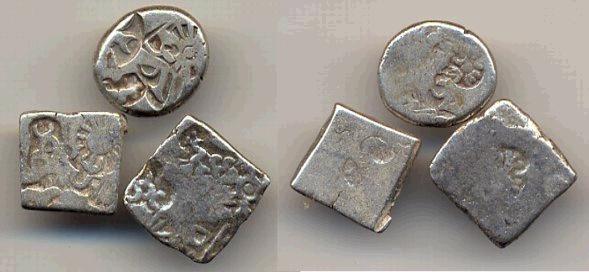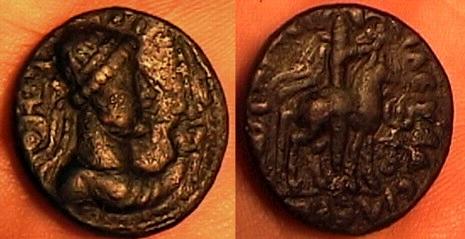Uniform weights, measurements, and currency
Weights and measurements
Measures of weight:
Raktika was the basic weight in ancient
India. Raktika was a bright red seed from the gunja. One raktika
would weigh about 118 grams. From all the records of weight we see
that they were not all consistent and sometimes were very different. The
goldsmith's scale given by Manu, which was probably the most widely followed,
was: (A.L. Basham)
5 ratikas = 1 masa,
16 masas = 1 karsa, tolaka, or suvarna,
4 karsas = 1 pala
10 palas = 1 dharana.
Each pala weighed about 1.33 oz. Prashta was
the unit used for heavier, which was usually given the value of 16 palas.
Drona was heavier then a prasthas and was usually. A drona would
usually weigh about 16 prathas.
Measurements of length:
8 yava (barleycorns) =
1 angula (.75 inches)
12 angulas = 1 vitasi (9 inches)
2 vitastis = 1 hasta or aratni
(18 inches)
4 hastas = 1 danda (6 feet)
2,000 dandas = 1 krosa (2.5 miles)
4 krosas = 1 yojana (about 9
miles)
Measurements of time:
18 nimesas = 1 kastha
(about 3.2 seconds)
30 kasthas = 1 kala (about 1.6 minuets)
15 kalas = 1 nadika (about 24 minuets)
2 nadikas = 1 muhurta (about 48 minuets)
30 muhurtas = 1 aho-ratra (about one day and night,
or 24 hours)
Currency:
There were five different
types of coins used throughout the Mauryan Empire These five different
types of coins are, in chronological order, early punched coins, Indo-Greek
coins, Kusana coins and Guptan coins, and Medieval coins.

Early punched coins were minted around the 6th
century B.C.E., and were used for many centuries. These coins were
made of gold, silver, or copper. Satamana was the largest coin and
was shaped like a small bent bar. One satamana would weigh about 180
grains. There were also different divisions of the satamana, such as
half, quarter, and half quarter. Karaspana was the basic silver punched
coin and kakinis was the basic copper coin.. There was only one gold
coin that had been found. From that we can assume that gold was very
rarely used to make money.
Indo-European coins were also made of gold, silver,
and copper. The Indo-European coins came from Rome during their expansion
southward into the area of Afghanistan. Silver coins, drachm and obol,
were the most abundant, copper coins, their metrology is not clear, (A.J.
Basham) the second most abundant, and gold coins were also very rare.

Kusana coins were only made of gold and copper. Dinaras
or suvarnas were based on Roman denarius. There were also double and
quarter dinaras. The copper Kusana coins were very large.
The Pre-Gupran coins were made of silver and copper.
These coins were not uniform in weight or size and were made by the
native king. There were also lead and potin coins from the Satavahanas
of the Deccan, and the Sakas of Gujarat made a distinctive series of coins
in silver. (A.J. Basham) The Guptas also made gold coins called dinara
and were made in relation to Kusana standards. The Indian standard
of coin was the copper coin called the karasapana, and the silver coin, rupaka,
was based on the Sakas of Ujjayini.
The Medieval coins were also made of gold, silver,
and copper. The gold coins were called suvarna or tanka and were only
minted in a few dynasties in the 11th century. The silver coins (dramma,
tanka) also conformed to this standard, and coins of 3/4, 1/2, and 1/4
dramma are attested. (A.J. Basham). There were many different
types of copper coins that were made during this time period.
The currency of the Mauryan Empire was very diverse
through out the many different emperors.
Back to main page

